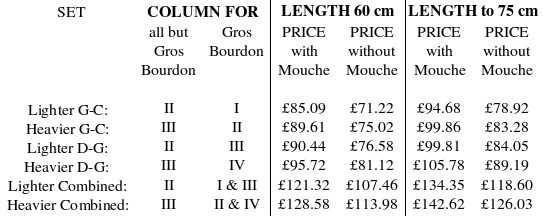
Northern Renaissance Instruments
6 Needham Avenue, Chorlton-cum-Hardy, Manchester M21 8AA, U.K.
Phone & Fax. +44 (0) 161 881 8134 ; proprietor: Dr. Ephraim Segerman [USA]
e-mail: post@nrinst.co.uk ; on internet: http://www.nrinst.co.uk
HURDY GURDY STRINGS
Many hurdy-gurdy players have tried modern types of strings on their instruments (e.g. metal or solid nylon, and metal wound on metal or on nylon floss), and found that gut, as the string material or as the core of a wound string, both sounds better and is easier to get to sound. When instruction books indicate that strings of the violin family are used for the hurdy gurdy, it is the gut versions of these strings that are implied.
Since the melody doesn’t cross strings In hurdy gurdies, choosing strings is a matter of finding the desired blend of sound, rather than balancing strings for equal output. Blend involves comparative loudness. The loudness of bowed strings is largely dependent on string tension. Different string tensions at the same pitch are achieved by different weights of the vibrating lengths of the strings. String diameter is a measure of the weight of a plain gut string, and equivalent diameter is the measure for a string with metal wound around the gut. The equivalent diameter (ED) is the diameter of a string made all of gut that would have the same weight as the whole wound string has.
In the blend most hurdy gurdy players prefer, the string tension is about 8 Kg on a high-pitched Chanterelle. If one Chanterelle is tuned an octave below the other, the tension on the lower one is usually at about half that of the other, or about 4 Kg. The tensions on the Trompette and the Petit Bourdon are also about 4 Kg, while that on the Mouche is about 3Kg, and on the Gros Bourdon is about 5 Kg.
Different hurdy gurdies often have different response characteristics, so they can have different blends of sound from identical sets of strings. Also, different players can prefer quite different blends. Consequently, more exacting players will experiment with different weights of strings to get the blends they want on their instruments. The ranges given in the Table represent what the vast majority of hurdy gurdy players use.
A plain gut string is made either with low or high twist of the gut strands in it. Low-twist strings are stronger, and when only these are offered in the Table, strength is needed to tune them up to the required pitches without breaking too often. The other unwound strings can be either low-twist or high-twist strings. High-twist strings are more brilliant (with more higher harmonics in the sound), and are recommended except for Chanterelles, where the stiffness of low-twist gut is usually preferred because it allows more of the pitch bending with key pressure used for expressiveness.
The diameters of plain gut strings and equivalent diameters of wound-on-gut strings in the Table of Specifications and Prices are listed in four columns: I, II, III and IV. For the strings other than the two Bourdons, the diameter differences between strings in adjacent columns is about 6%, with the one on the right just noticeably louder than the one on the left. Some prefer more equal octave Chanterelles, and use a column I for the first and column IV for the second. The differences between adjacent columns for the two Bourdons are twice as great as that for the thinner strings because taste concerning blend of sound varies much more. A player who likes a ‘cello G for the Petit Bourdon prefers a column IV string, while many others prefer a column I string. If the Gros Bourdon is only to be tuned to G, columns to the left are preferred. If it is only to be tuned to C or D, columns to the right are appropriate.
Except for the Gros Bourdon, diameters and ED’s in columns II and III are the most popular for all of the strings. For the Gros Bourdon, most people use weights in columns I or II. The string then works well when tuned to G, but is very weak when tuned to D. The use of column III and IV weights is rapidly growing for players who want a substantial D sound in D-G tuning or a low C in G-C tuning.
The popular sets listed below do not include strings listed as modern alternatives. The first four sets have 6 strings (5 strings if the instrument has no Mouche), but the G-C sets have one less packet (the two chanterelles are in one double length). The combined sets include the first Chanterelle and Gros Bourdon for each tuning, with the other strings common to both tunings (i.e. two more strings than the other sets).
PRICES of POPULAR SETS (2009)

Lighter sets could be more appropriate for instruments of lighter construction, and heavier sets for those of heavier construction, but the amount of sound output desired is usually the main criterion for choice; heavier becomes louder but is harder work.
Strings can be ordered individually according to diameter (or ED), column in the Table, the set it belongs to, or the same as was sent to you last time.
NOTE: Prices in this brochure do NOT include postage and packing.

